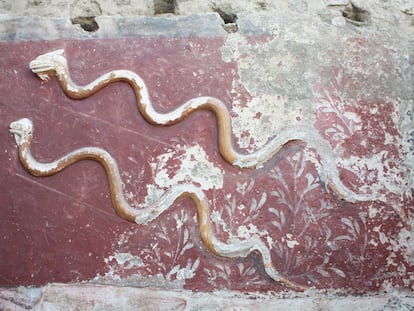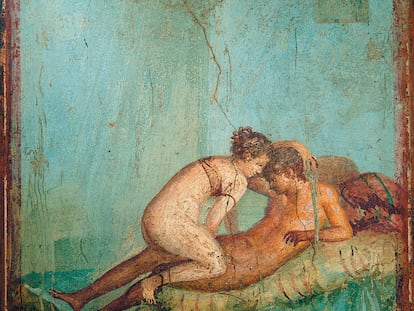Bodies, desire and pleasure in ancient Rome
Spanish historian Patricia González Gutiérrez teaches about sexuality and sensuality in the classical world, debunking contemporary thinking about the imagined past

When we evoke ancient Rome, we tend to imagine the Romans in a permanent orgy, in which eating, drinking and loving defined the days and nights of the aristocracy and plebeians. As the courtier Petronius said, the best thing was to go “directly from bed to the table.” One cannot help but think of the thousand kisses that Catullus gave his lover Lesbia, of Venus dissolving our bodies through the violence of enjoyment, of the frescoes depicting brothels in Pompeii, or of Ovid’s poetry about the art of love.
Spanish historian Patricia González Gutiérrez is a scholar of gender and sexuality in the classical world, particularly ancient Rome. She has several publications on contraception and abortion in Roman society, as well as essays that deal with the role of women. González Gutiérrez, who teaches at the Complutense University of Madrid, doesn’t shy away from the scandalous images and language that surround these subjects. Her work demands our attention when it comes to studying the intimate elements of ancient history.
It’s never easy to know what really happened in ancient Rome, but the historian thinks it’s fair to doubt that the extreme sexuality and sensuality, considered obscene or offensive from the perspective of prudish Christian morality, was really prevalent. She offers up the possibility that the supposedly ubiquitous eroticism in ancient Rome is, perhaps, more symbolic of how we’ve projected our own repressed desires and supposed sexual liberation onto an imagined past. The authentic and true Roman sexuality and sensuality may not match what modern times have depicted.
All that glitters isn’t necessarily sexuality. From González Gutiérrez’s publications, we learn that, where we see pure sexuality in ancient Roman society, the Romans may have seen religiosity, fertility, or amulets to ward off bad luck or the evil eye. She uses a strong theoretical framework — recalling Michel Foucault and the recently-deceased French historian Paul Veyne — to narrate the coercion of desire, the constructions of the body and a conception of sexuality in which power prevailed over pleasure. In ancient Rome, the sexual was also political: not a dialogue between equals, but a monologue of patriarchal rationale.
Extreme caution must be exercised so as not to make the mistake of seeing Roman sexuality as the liberating nature of an uninhibited sexuality. Similarly, one must not see Roman morality as an apology for carpe diem (“seizing the day”). The myths of Messalina — the third wife of Emperor Claudius, who had a reputation for promiscuity — or Marcus Aurelius, who was rumored to have been transgender, cannot be taken at face value, as their character traits may have been manipulated by their enemies.
It’s easy to make such mistakes from a decontextualized reading of Ovid or Marcus Valerius, from the amatory graffiti and the Priapean poems, or from using a purely sexual interpretation when looking at iconography of Pompeii’s erotic frescos, amulets, mirrors or skylights, which are filled with representations of satyrs, hermaphrodites and sex positions. González Gutiérrez emphasizes that we must put things in their correct place and refute the cliché of a Rome dominated by banquets and orgies. Where our gaze only sees eroticism and sexuality, there is also religion, superstition, magical thinking, humor, and fear.
Another kind of caution must also be observed: sexuality, heterosexuality, homosexuality, and bisexuality are all categories of analysis that arose in the 19th century. While they’re useful for us in contemporary times, they’re hardly applicable to Roman sexuality. This is because, among other reasons, sexuality in ancient Rome wasn’t articulated merely through biological sex. Rather, other factors played major roles, including social status, age, as well as the active or passive role represented in the sexual act. Depending on the specific context, sexual activity was applauded (or condemned) and passivity was censored (or encouraged). There were also varying places for women or lovers within the possessive morality of the men of ancient Rome.
The sexual is political, but above all, the sexual is moral. Rome was no exception in this: through the institution of marriage, or the uses and abuses of sexuality, a privileged place for men — and a subordinate place for women — was established in Roman morality. Of course, one must not lose sight of the fact that one thing is morality and another is reality. There’s available data that reveals to us how, in certain cases, Roman women had sovereignty over their sexuality and their bodies.
Perhaps it’s excessive to subscribe to the Pompeian inscription that proclaims: “Long live the one who loves; may he die he who does not know how to love, may he who puts obstacles in the path of love perish twice.” So, instead, long live the one who loves… and may he continue to enjoy the pleasure of reading works as suggestive and evocative as Patricia González Gutiérrez’s latest book, Eros and Cupid in Ancient Rome. Let us agree with Virgil and affirm that love conquers all. And let us give in to love.
Sign up for our weekly newsletter to get more English-language news coverage from EL PAÍS USA Edition
Tu suscripción se está usando en otro dispositivo
¿Quieres añadir otro usuario a tu suscripción?
Si continúas leyendo en este dispositivo, no se podrá leer en el otro.
FlechaTu suscripción se está usando en otro dispositivo y solo puedes acceder a EL PAÍS desde un dispositivo a la vez.
Si quieres compartir tu cuenta, cambia tu suscripción a la modalidad Premium, así podrás añadir otro usuario. Cada uno accederá con su propia cuenta de email, lo que os permitirá personalizar vuestra experiencia en EL PAÍS.
¿Tienes una suscripción de empresa? Accede aquí para contratar más cuentas.
En el caso de no saber quién está usando tu cuenta, te recomendamos cambiar tu contraseña aquí.
Si decides continuar compartiendo tu cuenta, este mensaje se mostrará en tu dispositivo y en el de la otra persona que está usando tu cuenta de forma indefinida, afectando a tu experiencia de lectura. Puedes consultar aquí los términos y condiciones de la suscripción digital.
More information
Archived In
Últimas noticias
Human rights activists, opposition members, and a minor: Maduro’s other political prisoners
Israel sparks a civil war within the MAGA movement
The complicated life of Francesca Albanese: A rising figure in Italy but barred from every bank by Trump’s sanctions
Pinochet’s victims grapple with José Antonio Kast’s rise in Chile
Most viewed
- Reinhard Genzel, Nobel laureate in physics: ‘One-minute videos will never give you the truth’
- Pablo Escobar’s hippos: A serious environmental problem, 40 years on
- Charles Dubouloz, mountaineering star, retires at 36 with a farewell tour inspired by Walter Bonatti
- Why we lost the habit of sleeping in two segments and how that changed our sense of time
- The Florida Keys tourist paradise is besieged by immigration agents: ‘We’ve never seen anything like this’










































